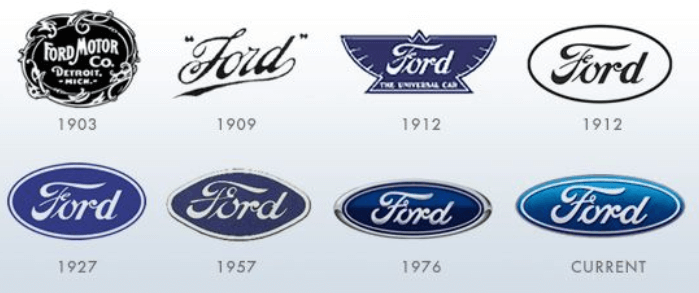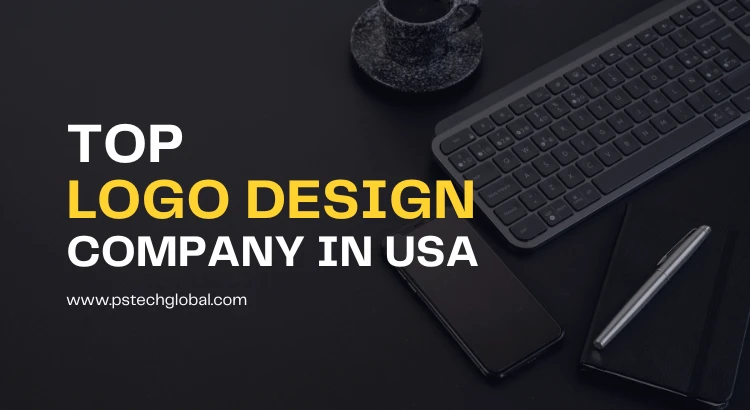Ford Motor Logo Over Time: The Complete Story and Design Evolution Behind America's Iconic Automotive Brand
Introduction: The Birth of an American Automotive Legend
The Ford Motor Company logo stands as one of the most recognizable automotive emblems in global history, representing over 120 years of American innovation, manufacturing excellence, and democratic mobility. From Henry Ford's handwritten signature to the modern blue oval that graces millions of vehicles worldwide, the Ford logo evolution tells a fascinating story of design adaptation, brand consistency, and strategic visual communication.
This comprehensive analysis explores the complete Ford logo timeline, examining each iteration's design philosophy, cultural context, and strategic purpose while revealing the profound ideas behind one of America's most enduring corporate identities.
You may also like to read: Tesla Motor Logo Story – Meaning & Evolution Behind the Icon
1903: The Genesis - Ford Motor Co. Detroit
The Original Vision and Art Nouveau Influence
The earliest Ford logo emerged in 1903, featuring an ornate, decorative emblem that reflected the Art Nouveau movement's influence on early 20th-century design. This inaugural logo showcased "Ford Motor Co. Detroit" within an elaborate circular border adorned with flourishes and decorative elements that emphasized craftsmanship and attention to detail.
The 1903 design represented Henry Ford's ambition to establish credibility in a nascent automotive industry dominated by established carriage manufacturers and mechanical workshops. The ornate styling communicated quality, precision, and manufacturing sophistication to consumers skeptical of motorized transportation reliability.
Strategic Brand Positioning Through Design
This original logo served multiple strategic purposes: establishing geographic identity (Detroit as automotive center), emphasizing corporate structure (Motor Co. designation), and communicating luxury through decorative elements. The circular format suggested completeness and reliability while the elaborate border work indicated meticulous attention to manufacturing details.
1909: The Script Revolution - Elegance in Motion
C. Harold Will's Typographic Masterpiece
In 1909, Ford introduced script lettering designed by C. Harold Will, first used on company correspondence before appearing on the Model A production car. This elegant script font featured flowing letterforms that embodied movement and grace, perfectly capturing the era's fascination with mechanical beauty and artistic expression.
The script design eliminated the ornate borders of the previous logo while maintaining sophistication through typography alone. This simplification reflected Henry Ford's emerging philosophy of functional efficiency that would later revolutionize automotive manufacturing through assembly line production.
Cultural Context and Market Positioning
The 1909 script logo coincided with Ford's transition from custom automotive production to systematic manufacturing. The flowing letterforms suggested motion and progress while maintaining the refinement expected by early automotive consumers who viewed motorcars as luxury items rather than practical transportation.
1912: The "Script with Wings" - Dynamic Movement Symbolism
Elongated Design and Motion Graphics
The 1912 iteration featured script lettering in elongated form known as the "script with wings," used until the current font emerged later that year. This dynamic design emphasized horizontal movement through extended letterforms that visually suggested speed and forward momentum.
The "wings" concept represented Ford's growing confidence in automotive technology and mass production capabilities. As the Model T gained popularity, the logo needed to communicate accessibility and reliability while maintaining visual interest and brand recognition.
Typography as Brand Personality
This period marked Ford's recognition that typography could effectively communicate brand personality without relying on decorative elements or complex imagery. The elongated script balanced elegance with dynamism, appealing to both traditional consumers and progressive early adopters embracing automotive technology.
1912: The Henry Ford Signature - Personal Brand Connection
Founder's Handwriting as Corporate Identity
The 1912 redesign introduced writing influenced by Henry Ford's own signature, creating a deeply personal connection between founder and brand. This approach established precedent for personal branding in corporate identity, making Ford Motor Company synonymous with its founder's vision and values.
According to design experts, the typography for Ford cars directly derives from founder Henry Ford's handwriting, creating authenticity and personal connection that differentiated Ford from competitors relying on generic typographic solutions.
Strategic Authenticity and Trust Building
By incorporating Henry Ford's actual handwriting into the corporate logo, the company communicated honesty, personal accountability, and founder commitment to quality. This strategy proved particularly effective during Ford's Model T mass production era, when personal touch seemed increasingly rare in industrial manufacturing.
You may also like to read: Best Motorcar Logos of All Time
1927: The Blue Oval Era Begins - Timeless Design Philosophy
Color Psychology and Brand Recognition
The 1927 Ford logo introduced the iconic blue oval format that would define the brand for nearly a century. The logo consistently incorporated variations of cobalt blue and silver as core brand colors, creating on-brand recognition regardless of specific design details.
Blue psychology conveys trust, reliability, and stability – essential qualities for automotive consumers concerned about mechanical dependability and long-term vehicle performance. The oval shape suggested infinity and continuity, reinforcing Ford's commitment to enduring quality and ongoing innovation.
Geometric Simplification and Mass Appeal
The oval format represented significant design simplification, eliminating decorative elements while maintaining visual impact through shape and color contrast. This approach aligned with Ford's mass production philosophy, creating a logo that could be efficiently reproduced across diverse applications from vehicle badges to advertising materials.
1957: Mid-Century Modernization - Streamlined Sophistication
Post-War Design Philosophy
The 1957 Ford logo refinement reflected mid-century modern design principles emphasizing clean lines, geometric precision, and functional aesthetics. This iteration maintained the blue oval concept while refining proportions and typography for enhanced readability and contemporary appeal.
The 1950s logo update coincided with Ford's expansion into international markets and product diversification beyond basic transportation. The modernized design communicated innovation and forward-thinking while preserving the brand heritage established through previous decades.
Technical Considerations and Media Adaptation
Mid-century logo design required consideration of emerging media channels including television advertising and color printing technologies. The refined Ford oval ensured consistent reproduction across diverse media while maintaining visual impact in both color and black-and-white applications.
1976: Contemporary Refinement - Precision and Clarity
Corporate Identity Systematization
The 1976 Ford logo represented comprehensive corporate identity systematization, establishing precise specifications for logo usage, color reproduction, and application guidelines. This professional approach reflected growing understanding of brand consistency importance across global markets and diverse product lines.
Design refinements focused on optical balance, ensuring the oval and typography appeared proportionally correct across various sizes and applications. Technical precision became paramount as Ford expanded globally and required consistent brand presentation across cultural and linguistic boundaries.
Brand Portfolio Integration
The late 1970s logo served as foundation for Ford's expanding brand portfolio, providing visual consistency across passenger cars, trucks, and emerging product categories. The refined design enabled effective sub-brand development while maintaining clear connection to parent company identity.
Current Era: Digital Age Adaptation - Timeless Meets Contemporary
Modern Color Palette and Digital Optimization
The current Ford logo represents subtle evolution rather than revolutionary change, demonstrating the enduring effectiveness of the blue oval concept. Modern iterations feature refined color gradients and enhanced contrast ratios optimized for digital media applications while preserving traditional brand recognition.
Contemporary design considerations include responsive scaling for mobile devices, social media profile compatibility, and high-resolution display optimization. These technical requirements influence color choices and detail levels while maintaining visual consistency with historical brand identity.
Global Brand Consistency and Cultural Adaptation
Today's Ford logo serves diverse global markets while maintaining consistent brand recognition across cultural boundaries. The simple oval format transcends linguistic differences while blue and silver color psychology translates effectively across international markets.
Design Philosophy Evolution: From Ornate to Essential
Simplification Through Strategic Reduction
Ford's logo evolution demonstrates strategic design simplification over 120 years, progressively eliminating decorative elements while preserving core brand recognition elements. This evolution reflects broader design philosophy shifts from ornate Victorian aesthetics to contemporary minimalism prioritizing functional clarity.
Each logo iteration removed unnecessary complexity while strengthening essential brand elements: the Ford name, oval format, and blue color palette. This reductive approach created increasingly versatile designs capable of effective reproduction across expanding media channels and application contexts.
Typography as Brand DNA
Ford's unique typography, inspired by founder Henry Ford's handwriting, creates deeply personal brand connection. This typographic consistency across logo iterations establishes visual continuity that transcends specific design details, ensuring brand recognition even when other elements change.
The handwriting-based font humanizes the corporate brand while communicating authenticity and founder commitment to quality. This personal touch differentiates Ford from competitors using generic typographic solutions, creating emotional connection that enhances brand loyalty.
Color Psychology and Strategic Communication
Blue: Trust, Reliability, and Innovation
Ford's consistent use of blue demonstrates trust, reliability, and stability – essential qualities for automotive consumers making significant financial investments in vehicle purchases. Blue psychology research indicates associations with dependability, professional competence, and technological innovation.
The specific cobalt blue shade selected by Ford conveys premium quality without appearing ostentatious, appealing to practical consumers seeking reliable transportation and enthusiasts appreciating automotive craftsmanship. This color choice supports Ford's democratic positioning as accessible luxury.
Silver and White: Precision and Purity
Complementary silver and white elements reinforce themes of precision manufacturing, technological advancement, and product purity. These metallic tones suggest industrial expertise while providing contrast that enhances logo readability across diverse backgrounds and applications.
The Failed Revolution: Paul Rand's Alternative Vision
Innovation Versus Tradition Tension
In the 1960s, Henry Ford II commissioned renowned designer Paul Rand to create a completely different logo design, but the radical departure from tradition proved too shocking, leading Ford II to abandon the project and retain the blue oval.
This episode demonstrates the delicate balance between innovation and brand heritage preservation. Even revolutionary companies must carefully consider the equity embedded in established visual identities before pursuing dramatic design changes.
Design Legacy and Brand Equity
The Rand experiment highlighted the substantial brand equity accumulated through consistent logo usage over decades. Ford's blue oval had become synonymous with automotive reliability and American manufacturing excellence, making dramatic changes potentially counterproductive to brand recognition and consumer trust.
Cultural Impact and Brand Recognition
Automotive Industry Leadership
Ford's logo evolution influenced automotive industry branding standards, demonstrating how consistent visual identity supports long-term brand building. The blue oval's success inspired competitors to develop similarly distinctive and enduring brand marks.
The logo's cultural penetration extends beyond automotive contexts, appearing in popular culture references, artistic interpretations, and cultural discussions about American industrial heritage. This broader recognition amplifies marketing effectiveness and brand value.
Global Recognition and Market Penetration
Ford's logo ranks among the world's most recognized corporate symbols, achieving instant identification across diverse global markets. This recognition translates directly into marketing efficiency, reducing advertising costs required to establish brand awareness in new markets or product categories.
Strategic Lessons for Modern Logo Design
Consistency Builds Equity
Ford's logo evolution demonstrates how consistent design elements build substantial brand equity over time. The blue oval concept, maintained for nearly a century, created recognition value that transcends specific design details or contemporary trends.
Simplification Enables Scalability
Progressive design simplification enabled Ford's logo to adapt effectively to changing media requirements and global market expansion. Complex decorative elements that worked in 1903 print applications would fail in contemporary digital contexts.
Personal Connection Enhances Authenticity
Incorporating founder Henry Ford's handwriting created authentic personal connection that differentiates the brand from competitors using generic design solutions. This personal touch continues resonating with consumers appreciating craftsmanship and founder commitment.
Technical Evolution: From Print to Digital
Media Adaptation Requirements
Ford's logo evolution reflects changing media landscape requirements, from ornate print advertisements to television commercials to contemporary digital applications. Each design iteration considered current reproduction technologies while anticipating future media developments.
Modern logo applications must function effectively across unprecedented range of contexts: vehicle badges, mobile app icons, social media profiles, digital billboards, and emerging augmented reality applications. This versatility requirement influences contemporary design decisions.
Production and Manufacturing Considerations
Logo design changes directly impact manufacturing costs through tooling modifications, badge production, and dealer signage updates. Ford's gradual evolution approach minimized these costs while maintaining brand recognition continuity.
Future Implications: Electric Era and Brand Evolution
Sustainable Transportation Positioning
As Ford transitions toward electric vehicle production, the traditional logo must communicate environmental responsibility while preserving automotive heritage. The blue oval's timeless design provides flexibility for sustainable messaging without requiring dramatic visual changes.
Digital-First Consumer Interaction
Contemporary consumers increasingly interact with Ford through digital channels before visiting physical dealerships. Logo design must optimize for smartphone screens, social media platforms, and emerging digital touchpoints while maintaining traditional recognition.
Conclusion: Timeless Design Principles and Enduring Brand Value
Ford's logo evolution over 120+ years demonstrates the power of strategic brand development, consistent visual identity, and thoughtful design adaptation. From ornate Art Nouveau origins to contemporary digital optimization, each iteration balanced innovation with heritage preservation while building substantial brand equity.
The story behind Ford's logo reveals fundamental design principles applicable across industries: simplification enables scalability, consistency builds recognition, personal connection creates authenticity, and strategic evolution preserves brand value while enabling contemporary relevance.
Henry Ford's original vision of democratic mobility continues resonating through the blue oval that graces millions of vehicles worldwide. This enduring symbol represents not just automotive manufacturing excellence, but American innovation, practical problem-solving, and the transformative power of thoughtful design applied consistently over generations.
The Ford logo stands as testament to the profound impact of strategic visual identity on business success, cultural influence, and brand longevity. Its evolution offers valuable lessons for any organization seeking to build lasting brand recognition while adapting to changing market conditions and consumer expectations.
As Ford enters the electric vehicle era and navigates digital transformation, the blue oval remains a powerful asset connecting past achievements with future possibilities – proving that exceptional design transcends specific technologies or market conditions to create enduring brand value that spans generations.
Understanding logo evolution and brand development? Professional design expertise ensures your brand achieves the recognition and longevity demonstrated by automotive icons like Ford. Strategic logo design creates lasting value that transcends trends while adapting to contemporary market requirements. Contact Us Today!

























